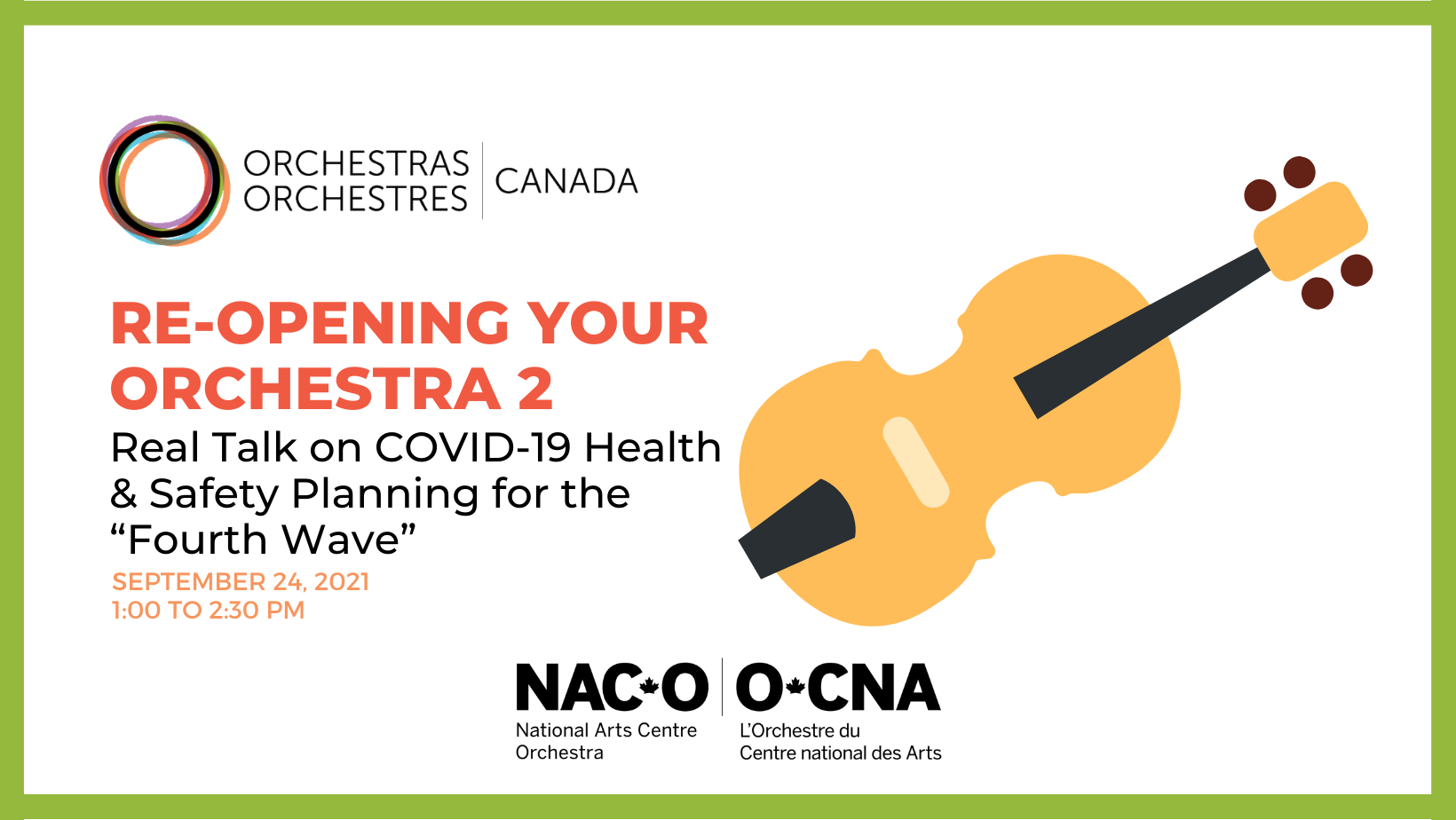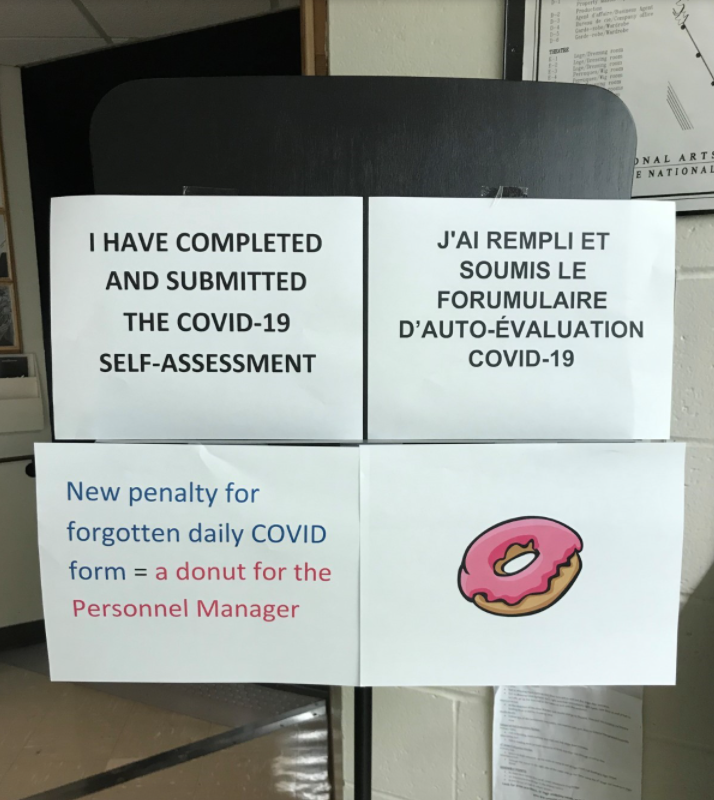
Key Insights from Re-Opening Your Orchestra 2, 2021
Real Talk on COVID-19 Health & Safety Planning for the “Fourth Wave”
On Friday, September 24th, 2021 Orchestras Canada welcomed performing arts health and safety expert, Janet Sellery CRSP, CHSC of Sellery Health + Safety along with the National Arts Centre Orchestra’s Meiko Lydall (Personnel Manager) and Christopher Millard (Principal Bassoon) for a panel discussion on how their organization has been approaching COVID-19 health and safety planning for this fall. They shared their silver lining moments, their challenges, how they’re handling communication with diverse orchestra stakeholders, and how they’ve coped with the changing regulations throughout the pandemic.
Here are a few key insights:
1. An “above and beyond” philosophy for health & safety
While the National Arts Centre convened a COVID-19 health and safety committee for the institution as a whole (which hosts multiple artistic disciplines), it became clear to Meiko and her NACO colleagues that the specialized concerns of a symphony orchestra called for a specialized approach. Thus, the NACO Re-Opening Committee was born, comprising representatives from both orchestra administration and musicians (initially wind and brass players, but now strings as well).
As NACO went back to work in the fall of 2020, they implemented detailed protocols for musicians and any crew entering the building (including the then-ubiquitous temperature check). You can review the orchestra’s health and safety plan for fall 2020 here. As more information became available about COVID 19 and its transmission, the committee shifted their focus to better understanding (and controlling) the aerosol droplets emitted by working musicians. They liaised with their building engineers and conducted fog studies to better understand air exchange rates and ventilation in Southam Hall, and tailored their health and safety approach accordingly.
As vaccinations and rapid testing for COVID-19 have become more widely available in Canada, the orchestra is now using both in tandem to keep musicians and staff safe. In addition to a mandatory vaccination policy, NACO maintains a contract with the Shoppers Drug Mart pharmacy chain for the administration of Abbott PanBio Rapid Antigen Tests. Meiko outlines the testing programme as follows:
Wind and brass players, who began last season utilizing bell barriers for the reduction of expelled aerosols, are permitted to remove bell barriers if they participate in the Rapid Testing programme within 48 hours before the first service of a workweek and upload confirmation of negative test to me. We have had a very consistent utilization of this testing programme. Fewer string players are taking advantage of the testing programme as most feel that their vaccination status and good masking are sufficient risk mitigation. However, out of concern for the uncertain transmission rates of the Delta variant within the community this Fall, the Centre is allowing any musicians concerned about family or social exposure to utilize the Rapid Test Screening more than once a week.
With many musicians and staff at the orchestra having young children or immunocompromised loved ones, this “above and beyond” approach to health and safety offers peace of mind in a stressful time.
2. To plexiglass or not to plexiglass?: Handling shifting knowledge and regulations
One major challenge for orchestras during the pandemic has been translating ever-evolving science and regulations into the best practices that keep your team safe — on and off stage. One such example is plexiglass. Broadly adopted at the outset, ongoing studies revealed that plexiglass barriers between musicians were less helpful at preventing aerosol transmission than initially thought. However, in Ontario (where NACO is based), the regulations needed some time to catch up with the science.
Meiko describes NACO’s approach to this issue below:
Early on, Ontario regulations were demanding plexiglass partitions on stages. Based on our reading of the emerging research from both Europe and the States, we were only briefly enthusiastic about plexiglass barriers. We came to the conclusion that the viral danger from exhaled aerosols was not effectively managed by barriers and enclosing musicians in glass cages ends up being of little statistical benefit. However, the provincial rules mandated their presence, so we used our fog studies to at least use our required plexiglass in ways that helped redirect downstage airflow up and over the string sections.
Despite the temporary discrepancy between science and regulation, the team determined a way to meet their regulatory obligations and ensure optimal health and safety in their space. And, at the time of writing, plexiglass is no longer required in Ontario between musicians, though it is still required between musicians and audiences if 2 metres distancing cannot be maintained.
3. Advance communication, trust, and managing the “firehose of information”
Meiko, Chris, and Janet discussed the abundance of information and the challenge of sorting for what’s most useful/relevant to your orchestra. In Chris’ words, “We couldn’t find any 1-800 numbers to dial about trumpet aerosols or safe air exchange rates.” Throughout the pandemic, Chris has spent hours reading scientific studies out of personal fascination and supporting his work on the ReOpening Committee. However, he notes, it was neither feasible nor helpful to share every detail with the rest of the orchestra.
In the end, NACO focused their communication to the orchestra on three specific areas:
- Air exchange rates and the dynamics of airflow patterns on stage
- Masking technologies and their utilization
- Issues specifically concerning wind and brass participation
To build trust and keep everyone on the same page, Meiko emphasized that in addition to musician representation on the ReOpening Committee, it was important to communicate with the orchestra early and often as information that affects them became available — especially with changes to tangible health and safety practices. For example, when the decision was made to remove plexiglass barriers between musicians during rehearsal, Meiko did two things: 1) She sent an email in advance to all musicians explaining why the decision was made and how the change would manifest at rehearsals, and 2) She spoke to the orchestra at the beginning of that first rehearsal to reinforce the information that had already been communicated in writing. And the orchestra cheered at the news!
Orchestras Canada thanks Janet, Meiko and Chris for sharing their time and insight with us on September 24. We’re grateful for their care, thoughtfulness, and willingness to share, and the ways that they modelled respectful collaboration at a time of turmoil. Please enjoy this donut image from Meiko as much as we do!

Resources from speakers:
From Janet Sellery, CRSP, CHSC, Sellery Health + Safety:
1. Health & Safety Resources List (September 24, 2021 — NOTE: Based primarily on Ontario COVID-19 requirements)
CONTACT:
Janet Sellery, CRSP, CHSC
Sellery Health + Safety
[email protected]
www.selleryhealthandsafety.com
From the National Arts Centre Orchestra (NACO):
1. NACO Re-Entry Preparedness Plan (September 25, 2020 – LAST SEASON)
2. NACO Upgraded Masking Recommendations (February 12, 2021 – LAST SEASON)
NOTE: these are two sample documents from last season’s health and safety communications to the National Arts Centre Orchestra. During the session, Meiko Lydall and Christopher Millard discussed how the orchestra’s approach to COVID-19 health and safety has evolved over the past year.
